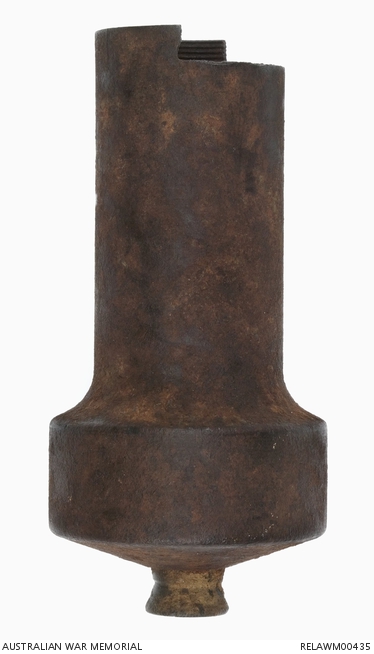| Place | Middle East: Ottoman Empire, Turkey, Dardanelles, Gallipoli |
|---|---|
| Accession Number | RELAWM00435 |
| Collection type | Technology |
| Object type | Grenade |
| Physical description | Cast iron |
| Maker |
Unknown |
| Place made | United Kingdom: England |
| Date made | c 1915 |
| Conflict |
First World War, 1914-1918 |
Garland trench mortar grenade : The Nek, Gallipoli

Remains of a Garland mortar grenade. It consists of the cast iron case of the grenade, similar in shape to a mushroom. This example retains its shipping plug still screwed in place. Prior to firing, this plug was removed and replaced with a bronze screw-threaded pin. This pin was supplied screwed in to the side of the grenade, and when unscrewed, allowed an internal zinc tube containing a detonator to slide forward. If the bronze pin was screwed into the front of the device, it acted as a firing pin, as the detonator slid forward against it when the grenade hit the ground. The metal is lightly corroded and there are remains of dried mud.
This bomb was collected by members of the Australian Historical Mission (AHM) on 19 February 1919. The AHM, led by Official Historian C E W Bean, visited Gallipoli from February to March 1919 to collect items for the nation, to record the area through artworks and photographs, and to explore the battlefields to answer some of the 'riddles of Anzac' for the Australian official history of the war. They noted that the grenade was used by Australians at the Nek in August 1915.
The Garland grenade was generally used with the Garland trench mortar at Gallipoli, although it could be thrown. The grenade consisted of this metal case with a brass top containing the percussion cap. The explosive, three ounces of gelignite, were contained in a sliding zinc cylinder which also contained the detonator and hollow firing pin. The rear of the grenade was made form a shaped wooden block with a recess for a streamer or tail and a metal base plate. Upon firing the wooden block would come away and the streamers would fall out. The grenade would land head first and the pin would hit the percussion cap, igniting the detonator, causing the grenade to explode.